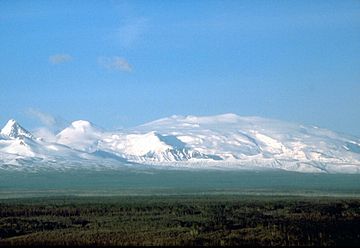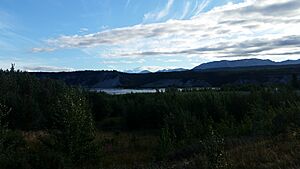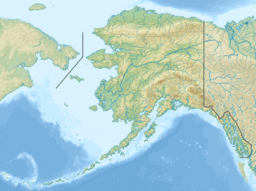Mount Wrangell facts for kids
Quick facts for kids Mount Wrangell |
|
|---|---|

Mount Wrangell, 1987
|
|
| Highest point | |
| Elevation | 14,163 ft (4,317 m) NAVD88 |
| Prominence | 5,613 ft (1,711 m) |
| Isolation | 14.79 mi (23.8 km) |
| Listing |
|
| Geography | |
| Location | Wrangell-St. Elias National Park and Preserve, Alaska, U.S. |
| Parent range | Wrangell Mountains |
| Topo map | USGS Gulkana A-1 |
| Geology | |
| Age of rock | Pleistocene |
| Mountain type | Shield volcano |
| Volcanic arc/belt | Wrangell Volcanic Field |
| Last eruption | August 2002 |
Mount Wrangell is a giant shield volcano in Alaska, United States. It's found in the Wrangell–St. Elias National Park and Preserve. The local Ahtna people call it K’ełt’aeni. When it's erupting, they call it K’ełedi.
This huge mountain rises more than 12,000 feet (3,700 meters) above the Copper River. It is part of the Wrangell Volcanic Field. This volcanic area stretches over 250 kilometers (155 miles) across Alaska and into Canada. Mount Wrangell has been active for a very long time, from the Pleistocene to today.
Contents
What is Mount Wrangell Like?
Mount Wrangell is built on an older volcano. Its history of eruptions goes back 750,000 years. There were small steam eruptions as recently as 1884.
The top of this shield volcano has a large, ice-filled caldera. A caldera is a big bowl-shaped hollow. This one is about 2.5 by 3.7 miles (4 by 6 kilometers) wide. It formed when the ground sank, not from a huge explosion.
Around the caldera, there are three smaller craters. These craters often release steam, which can be seen from far away. The highest point of the mountain is on the north side of this caldera. Another peak, the west summit, reaches 14,013 feet (4,271 meters).
The flat top of the mountain, above 13,000 feet (4,000 meters), is very wide. It measures over 2 by 5 miles (3 by 8 kilometers). There is also a very large cinder cone nearby called Mount Zanetti. It is 13,009 feet (3,965 meters) tall. Mount Zanetti rises almost 1,000 feet (300 meters) above Wrangell's side. It has also produced some lava flows.

Mount Wrangell is almost completely covered by a thick layer of ice and snow. This icefield stays there all year round. The biggest glacier on Mount Wrangell is the Nabesna Glacier. This glacier is the source of the Nabesna River. Other glaciers on the mountain include Cheshnina Glacier, Chetaslina Glacier, Chichokna Glacier, Dadina Glacier, and Copper Glacier.
Mount Wrangell was the first tall volcano in the Wrangell mountain range to be climbed. People can even visit its summit by taking a special airplane with skis!
How Mount Wrangell Got Its Name
Mount Wrangell is named after Russian Admiral Ferdinand von Wrangel. He was the governor of Russian America from 1830 to 1836.
The Ahtna people have their own names for the mountain. They call it K'elt'aeni, which means "the one who controls the weather." When the volcano is active, they use the name Uk'eledi, meaning "the one with smoke on it." Before the 1900s, some maps called it Mount Tillman.
Volcanic Activity and Eruptions
Mount Wrangell is the only volcano in the Wrangell Volcanic Field that has had recorded eruptions. These eruptions have usually been small bursts of steam and ash. People reported activity in 1784 and again in 1884–85. The 1784 eruption and another one said to be in 1760 are not fully confirmed. A local explorer named Jon Bremner reported the 1884-85 eruption. In 1890, there was a report of a visible glow from the mountain.
Mount Wrangell also sometimes releases ash. You can see this ash coating the snow on its summit. Most of the mountain was formed by large lava flows. These flows happened between 600,000 and 200,000 years ago. Scientists believe the summit caldera collapsed sometime in the last 200,000 years. It might have even collapsed about 50,000 years ago. Mount Zanetti, the large cinder cone, is about 25,000 years old.
From the 1950s to the 1980s, the amount of heat coming from Mount Wrangell increased. This made some people think a new eruption might happen. The heat was so strong that it melted ice around the craters. This created ice caves and small lakes in the north crater. By 1986, about 100 million cubic meters of ice had melted. However, since then, the heat has decreased, and ice has started to build up again.
See also
 In Spanish: Monte Wrangell para niños
In Spanish: Monte Wrangell para niños




